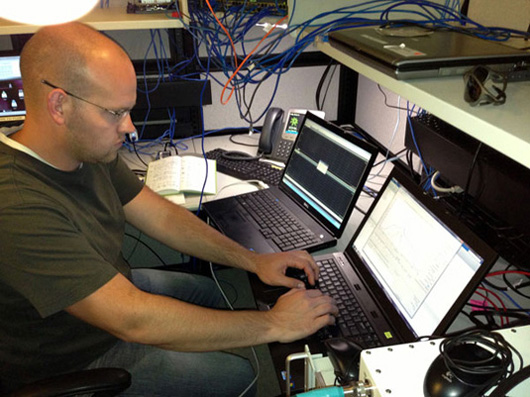Spectrum Sharing Innovation Test-Bed
The National Telecommunications and Information Administration (NTIA), in coordination with the Federal Communications Commission (FCC) and the Federal agencies, established a Spectrum Sharing Innovation Test-Bed (Test-Bed) pilot program to examine the feasibility of increased sharing between Federal and non-Federal users. This pilot program is an opportunity for the Federal agencies to work cooperatively with industry, researchers, and academia to objectively examine new technologies that can improve management of the nation's airwaves.
Test-Bed Pilot Program
The Test-Bed Pilot Program will evaluate the ability of Dynamic Spectrum Access (DSA) devices employing spectrum sensing and/or geo-location techniques to share spectrum with land mobile radio systems operating in the 410-420 MHz Federal band and 470-512 MHz non-Federal band. The Test-Bed Pilot Program will be performed in three phases:
1) Equipment Characterization. Equipment employing DSA techniques will be sent to the NTIA Institute for Telecommunication Sciences in Boulder, Colorado and characterization measurements of the DSA capabilities in response to simulated environmental signals will be performed.
2) Evaluation of Capabilities. After successful completion of Phase 1, the DSA capabilities of the equipment in the geographic area of the Test-Bed will be evaluated.
3) Field Operation Evaluation. After successful completion of Phase 2, the DSA equipment will be permitted to transmit in an actual radio frequency signal environment. An automatic signal logging capability will be used during the operation of the Test-Bed to help resolve interference events if they occur. A point-of-contact will also be established to stop Test-Bed operations if interference is reported
Test-Bed Participants:
- Adapt4 LLC
- Adaptrum Inc.
- BAE Systems
- Shared Spectrum Company
Related content
Exploring Spectrum Sharing Through Technical Studies
Recognizing the importance of making additional spectrum available for wireless broadband to drive innovation, expand consumer services, and promote continued economic growth, NTIA is working hard to explore new options for federal government and industry to share spectrum. The Obama Administration is committed to making available an additional 500 MHz of spectrum for commercial use this decade, and spectrum sharing will be a critical component of that effort.

NTIA/ITS engineer John Carroll using a computer-controlled measurement system to gather data on radar-to-LTE interference effects. Photo by Frank Sanders.
NTIA Letter to FCC on Advanced Wireless Services (AWS-3) Rulemaking
In this letter, NTIA responds to the AWS-3 NPRM for purposes of: (1) supplementing the information NTIA submitted to the FCC in July and April 2013 prior to adoption of the NPRM; (2) proposing specific changes to the U.S. Table of Frequency Allocations for the 2025-2110 MHz band that are necessary to implement the alternative proposal of the Department of Defense (DoD) to relocate key operations from the 1755-1780 MHz band; and (3) addressing other important issues raised in the NPRM.
Innovative Spectrum Sharing Technology Day Presentation Slides
This document should be considered unclassified and free for public release with no restrictions. This document was incorrectly labeled.
The NIST-NTIA presentation slides from the 11/06/2013 Innovative Spectrum Sharing Technology Day are attached.
